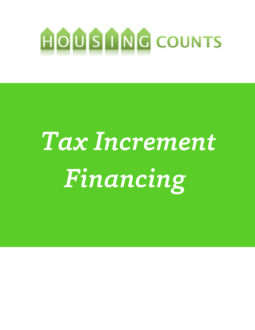Utilize Tax Increment Financing (TIF) to Fund a Mix of Housing
Tax increment financing (TIF) is a method of financing costs associated with public improvements such as streets, sidewalks, sewer and water, and real estate development. The TIF encourages developers to construct buildings and make other private improvements on a site that without the TIF funding would otherwise not be developed. TIF districts allow a city to capture new taxes generated by new development and use them to help finance the development. Once the TIF district expires, the municipality will receive the full benefit of the property taxes on a much higher property tax base than would otherwise have been present without the investments. In Minnesota, when a TIF district is created, the county auditor certifies the current tax capacity of the properties in the district as the TIF district’s “original tax capacity.” Later as the properties in the district increase in value, increases beyond the original tax capacity are “captured.” The law refers to this increase as the district’s “captured tax capacity.” The county auditor also certifies an “original tax rate.” The original tax rate is total property tax rate that applies in the district, i.e., the tax rates imposed by all of the local governments that levy taxes (the city/town, county, school district, and special taxing districts).The “tax increment” or “increment” for the district is determined by multiplying the original tax rate by the captured tax capacity. This roughly equals the additional taxes paid by the captured tax capacity or the increase in taxes that occur as a result of the development. The tax increment is used to finance development in two ways.
- The city can sell bonds repayable from the increment and invest the bond proceeds in the development.
- The developer can cover all these costs, and be repaid for some of them with a semi-annual rebate of the incremental portion taxes paid by the development. This is called pay-as-you-go TIF which has the advantage of shifting risk that the projected increment may not materialize to the developer.
How is TIF used for affordable housing?
In Minnesota TIF traditionally was used as a means of redeveloping urban areas that had old or worn-out buildings in need of replacement or rehabilitation. It was initiated as a tool to help with urban renewal (redeveloping “slums” and “blighted” areas). Its use has since spread to other purposes such as cleaning up pollution and providing economic development incentives. TIF has also become an extremely useful tool for development of low and moderate income housing. TIF bond proceeds can be used to make housing more affordable for lower income households by subsidizing the cost of the development of the housing or of infrastructure required for the housing. Or pay-as-you-go TIF can permit lower cost to residents by reducing the taxes that rents must cover.
What problems are solved by TIF policies?
Housing TIF districts permit collection of the increment for 25 years in order to finance projects which are at least partly to be occupied by lower income households. Learn about minimum requirements for Housing TIF districts. In short, State TIF statute sets income limits for projects assisted with housing TIF, but does not specify rent or ownership cost limits. Cities should impose these limits at no higher than 30% of the maximum income level. The statute does not require that income limits be imposed on ownership housing after the first buyer. Cities should consider requiring income limits for the first and future buyers to ensure long term affordability. Otherwise, the benefits of the TIF investment may last for only a few years, with the first buyer benefiting from the TIF subsidy if they sell prior to the duration of the TIF.
Housing TIF districts also have the unique feature that the increment generated can be used anywhere in the city to assist housing occupied at least in part by lower income households. In the City of Chaska, the Clover Ridge TIF district was created to meet an affordable workforce housing need within the growing suburban community. The district initially provided resources to provide assistance to owner occupants within the district, but since has continued to generate funds for the City’s Housing Trust Fund. Learn more about the original Clover Ridge TIF policies. TIF from non-housing districts can be used to assist in the development of market rate housing. However, the City of Minnetonka has long required an affordable component in any residential project where TIF financing is provided.
The City of St. Louis Park also adopted a similar policy in June of 2015 requiring at least 10% of the total units in a development provided at affordable rents or values. Within a few months of St. Louis Park’s adoption of the policy, four of five pending new developments were asking for TIF, and at least two of those planned to seek tax exempt bond and 4% tax credit financing and therefore would have at least 20% affordable units. Learn more about the City of St. Louis Park’s affordable housing policy. TIF is also a tool to assist with brownfield redevelopment. Specifically, using tax increment financing for environmental remediation is permitted under enabling statutes in Minnesota with special laws (beyond the State’s regular TIF law) dedicated to this purpose.
Where has TIF been used?
The City of Golden Valley used TIF funds for the Golden Valley Town Square development.
